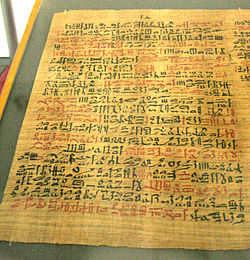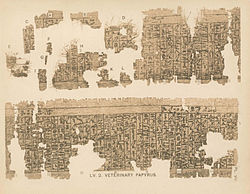| Papyrus Name | Other names | Dating | Language | Medical specialties | Contents | Scribe/Author | Date & place of discovery | place of preserving | size | image |
|---|
| Edwin Smith Papyrus | Edwin Smith Surgical Papyrus | dates to Dynasties 16–17 of the Second Intermediate Period in ancient Egypt, c. 1500 BC, but believed to be a copy from Old Kingdom, 3000–2500 BC | Hieratic | The oldest known surgical treatise on trauma | The vast majority of the papyrus is concerned with trauma and surgery, with short sections on gynaecology and cosmetics on the verso. On the recto side, there are 48 cases of injury. The verso side consists of eight magic spells and five prescriptions. The oldest known surgical treatise on trauma | Attributed by some to Imhotep | Luxor, Egypt before 1862 | New York Academy of Medicine | a scroll 4.68 m in length. The recto (front side) has 377 lines in 17 columns, while the verso (backside) has 92 lines in five columns |  |
| Ebers Papyrus | Papyrus Ebers | c. 1550 BC but believed to be a copy from earlier texts of 3400 BC | Hieratic | Medicine, Obestitrics & gynecology & Surgery | The scroll contains some 700 magical formulas and remedies, chapters on contraception, diagnosis of pregnancy and other gynecological matters, intestinal disease and parasites, eye and skin problems, dentistry and the surgical treatment of abscesses and tumors, bone-setting and burns | N/A | Assassif district of the Theban necropolis before 1862 | Library of University of Leipzig, Germany | a 110-page scroll, which is about 20 meters long |  |
| Kahun Gynaecological Papyrus | Kahun Papyrus, Kahun Medical Papyrus, or UC 32057 | c. 1800 BC | Hieratic | Medicine, Obestitrics & gynecology, pediatrics and veterinary medicine | The text is divided into thirty-four sections that deals with women's health—gynaecological diseases, fertility, pregnancy, contraception, etc. The later Berlin Papyrus and the Ramesseum Papyrus IV cover much of the same ground, often giving identical prescriptions | N/A | El-Lahun by Flinders Petrie in 1889 | University College London | 2 gynecologic papyri & 1 veterinary payrus |  |
| Ramesseum medical papyri | Ramesseum medical papyri parts III, IV, and V | 18th century BC | Hieroglyphic & Hieratic | Medicine, gynecology, ophthalmology, rheumatology & pediatrics | A collection of ancient Egyptian medical documents in parts III, IV, and V, and written in vertical columns that mainly dealt with ailments, diseases, the structure of the body, and supposed remedies used to heal these afflictions. namely ophthalmologic ailments, gynaecology, muscles, tendons, and diseases of children | N/A | Ramesseum temple | Oxford Ashmoulian Museum | 3 papyri (parts III, IV, V) | N/A |
| Hearst papyrus | Hearst Medical Papyrus | 18th Dynasty of Egypt, around time of Tuthmosis III c. 0000 but believed to have been composed earlier, during the Middle Kingdom, around 2000 BC | Hieratic | Urology, Medicine and bites | 260 paragraphs on 18 columns in 18 pages of medical prescriptions for problems of urinary system, blood, hair, and bites | N/A | discovered by an Egyptian peasant of village of Der-el-Ballas before 1901 | Bancroft Library, University of California | 18 pages |  |
| London Medical Papyrus | BM EA 10059 | 19th dynasty 1300 BC or c. 1629–1628 BC | Hieratic | skin complaints, eye complaints, bleeding, miscarriage and burns | 61 recipes, of which 25 are classified as medical the remainder are of magic | N/A | N/A | Royal institute of London | |  |
| Papyrus Berlin 3038 | Brugsch Papyrus, the Greater Berlin Papyrus | 19th dynasty, and dated c. 1350–1200 BC | Hieratic? | Medical | discussing general medical cases and bears a great similarity to the Ebers papyrus. Some historians believe that this papyrus was used by Galen in his writings | 24 pages (21 to the front and 3 on the back) | N/A | Discovered by an Egyptian in Saqqara before 1827 | Berlin Museum | N/A |
| Carlsberg papyrus | N/A | between the 19th and 20th dynasties, New Kingdom; its style relates it to the 12th dynasty. Some fragments date back to c. 2000 BC, others—the Tebtunis manuscripts—date back to c. 1st century AD | Hieratic, Demotic. Hieroglyphs and in Greek | Obestitrics & gynecology, Medicine, Pediatrics & ophthalmology | The structure of the papyrus bears great resemblance to that of the Kahun and Berlin papyri. | N/A | N/A | N/A | Egyptological Institute of the University of Copenhague | N/A |
| Chester Beatty Medical Papyrus | Chester Beatty Papyri, Papyrus VI of the Chester Beatty Papyri 46 (Papyrus no. 10686, British Museum), Chester Beatty V BM 10685, VI BM 10686, VII BM 10687, VIII BM 10688, XV BM 10695 | dated around 1200 BC] | Hieratic? | Headache, and Anorectal disorders | Magic spells and medical recipes for headache & anorectal disease | N/A | started off as a private collection by the scribe Qen-her-khepeshef in the 19th Dynasty and passed on down through his family until they were placed in a tomb | Deir el-Medina (the workers village) in 1928 | British Museum | N/A |
| Brooklyn Papyrus | 47.218.48 och 47.218.85, also known as the Brooklyn Medical Papyrus | a collection of papyri which belong to the end of the 30th dynasty, dated to around 450 BC, or the beginning of the Ptolemaic Period. However, it is written with the Middle Kingdom style which could suggest its origin might be from the Thirteenth dynasty of Egypt | Hieratic? | deals only with snakes and scorpion bites, and the formulae to drive out the poison of such animals | It speaks about remedies to drive out poison from snakes, scorpions and tarantulas. The style of these remedies relates to that of the Ebers papyrus | a scroll of papyrus divided into two parts with some parts missing, its total length is estimated to 175 × 27 cm | N/A | might originate from a temple at ancient Heliopolis, discovered before 1885 | Brooklyn Museum in New York |  |
| Erman Papyrus | given with the Westcar papyrus to Berlin museum | Middle dated from the beginning of the New Kingdom (16th century BC) | ??? | Medicine, Magic & Anatomy | Holds some medical formulae and a list of anatomic names (body and viscera) and about 20 magical formulae | N/A | N/A | before 1886 AD | Berlin Museum | N/A |
| Leiden Papyrus | Rijksmuseum, Leiden 1343–1345 | 18th–19th dynasties | ??? | Medicine, Magic | It mostly deals with magical texts | N/A | N/A | N/A | Rijks museum, Leiden |  |











